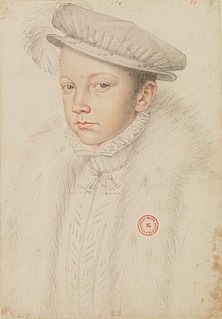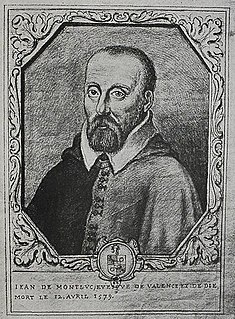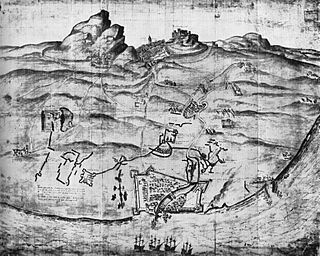| |||||
| Centuries: | |||||
|---|---|---|---|---|---|
| Decades: | |||||
| See also: | List of years in Scotland Timeline of Scottish history 1560 in: England • Elsewhere | ||||
Events from the year 1560 in the Kingdom of Scotland .
| |||||
| Centuries: | |||||
|---|---|---|---|---|---|
| Decades: | |||||
| See also: | List of years in Scotland Timeline of Scottish history 1560 in: England • Elsewhere | ||||
Events from the year 1560 in the Kingdom of Scotland .

Year 1560 (MDLX) was a leap year starting on Monday of the Julian calendar.

Francis II was King of France from 1559 to 1560. He was also King consort of Scotland as a result of his marriage to Mary, Queen of Scots, from 1558 until his death in 1560.

Mary of Guise, also called Mary of Lorraine, was a French noblewoman of the House of Guise, a cadet branch of the House of Lorraine and one of the most powerful families in France. She was Queen of Scotland from 1538 until 1542, as the second wife of King James V. As the mother of Mary, Queen of Scots, she was a key figure in the political and religious upheaval that marked mid-16th-century Scotland, ruling the kingdom as regent on behalf of her daughter from 1554 until her death in 1560.
The Treaty of Edinburgh was a treaty drawn up on 5 July 1560 between the Commissioners of Queen Elizabeth I of England with the assent of the Scottish Lords of the Congregation, and the French representatives of King Francis II of France to formally conclude the siege of Leith and replace the Auld Alliance with France with a new Anglo-Scottish accord, while maintaining the peace between England and France agreed by the Treaty of Cateau-Cambrésis.

The Lords of the Congregation, originally styling themselves "the Faithful", were a group of Protestant Scottish nobles who in the mid-16th century favoured a reformation of the Catholic church according to Protestant principles and a Scottish-English alliance.
The Book of Discipline refers to two works regulative of ecclesiastical order in the Church of Scotland, known as The First Book of Discipline (1560) and The Second Book of Discipline (1578), drawn up and printed in the Scottish Reformation. The first was drafted by a committee of "six Johns", including leading reformer John Knox. It set out a system of Presbyterian polity on the Geneva model, but the lack of funds meant its programme of clerical organisation and education was largely abandoned. The second book was adopted after the forced abdication of Mary Queen of Scots and was much more clearly Presbyterian in outlook. It placed church supervision fully in the hands of groups of elected church leaders in presbyteries.

Admiral Sir William Wynter was an admiral and principal officer of the Council of the Marine under Queen Elizabeth I of England and served the crown during the Anglo-Spanish War (1585–1604).

The Scottish Reformation was the process by which Scotland broke with the Papacy and developed a predominantly Calvinist national Kirk (church), which was strongly Presbyterian in its outlook. It was part of the wider European Protestant Reformation that took place from the sixteenth century.
The Scottish Reformation Parliament was the assembly commencing in 1560 that claimed to pass major pieces of legislation establishing the Scottish Reformation, most importantly the Confession of Faith Ratification Act 1560; and Papal Jurisdiction Act 1560.

Jean de Monluc, c. 1508 to 12 April 1579, was a French nobleman, clergyman, diplomat and courtier. He was the second son of François de Lasseran de Massencome, a member of the Monluc family; and Françoise d' Estillac. His birthplace is unknown, but it has been observed that his parents spent a great deal of time at their favorite residence at Saint-Gemme in the commune of Saint-Puy near Condom. His elder brother Blaise de Montluc became a soldier and eventually Marshal of France (1574).

The European wars of religion were a series of wars waged in Europe during the 16th, 17th and early 18th centuries. Fought after the Protestant Reformation began in 1517, the wars disrupted the religious and political order in the Catholic countries of Europe, or Christendom. Other motives during the wars involved revolt, territorial ambitions and great power conflicts. By the end of the Thirty Years' War (1618–1648), Catholic France had allied with the Protestant forces against the Catholic Habsburg monarchy. The wars were largely ended by the Peace of Westphalia (1648), which established a new political order that is now known as Westphalian sovereignty.

The Treaty of Berwick was negotiated on 27 February 1560 at Berwick-upon-Tweed. It was an agreement made by the representative of Queen Elizabeth I of England, the Duke of Norfolk, and the group of Scottish nobles known as the Scottish Lords of the Congregation. The purpose was to agree the terms under which an English fleet and army would come to Scotland to expel the French troops who were defending the Regency of Mary of Guise. The Lords were trying both to expel the French and to effect the Scottish Reformation, and this led to rioting and armed conflict.

The siege of Leith ended a twelve-year encampment of French troops at Leith, the port near Edinburgh, Scotland. The French troops arrived by invitation in 1548 and left in 1560 after an English force arrived to attempt to assist in removing them from Scotland. The town was not taken by force and the French troops finally left peacefully under the terms of a treaty signed by Scotland, England and France.
Sir James MacGill, Lord Rankeillor of Nether Rankeillour. was a Scottish courtier and Senator of the College of Justice.

Henri Cleutin, seigneur d'Oisel et de Villeparisis, was the representative of France in Scotland from 1546 to 1560, a Gentleman of the Chamber of the King of France, and a diplomat in Rome 1564-1566 during the French Wars of Religion.

Jacques de la Brosse, cupbearer to the king, was a sixteenth-century French soldier and diplomat. He is remembered in Scotland for his missions in 1543 and 1560 in support of the Auld Alliance.
The Battle of Glasgow, 18 March 1560, was fought by supporters of the Scottish Reformation against French troops.
James Somerville, 6th Lord Somerville, (c.1518-1569) was a Lord of the Parliament of Scotland

The Articles of Leith were the terms of truce drawn up between the Protestant Lords of the Congregation and Mary of Guise, Regent of Scotland and signed on 25 July 1559. This negotiation was a step in the conflict that led to the Scottish Reformation. Although its immediate effect was the withdrawal of Protestant forces from Edinburgh, subsequent disputes over the content and observance of the treaty fuelled the crisis in Scotland.
Corbeyran de Cardaillac de Sarlabous was a 16th-century French soldier who served in Scotland as Captain of Dunbar Castle, and was Governor of Le Havre for twenty years. He was usually called Captain Sarlabous in Scottish and English letters of his time. A contemporary French writer calls him the "sieur de Sarlaboz." Sarlabous is a place in the Hautes-Pyrénées where Corbeyran held lands.